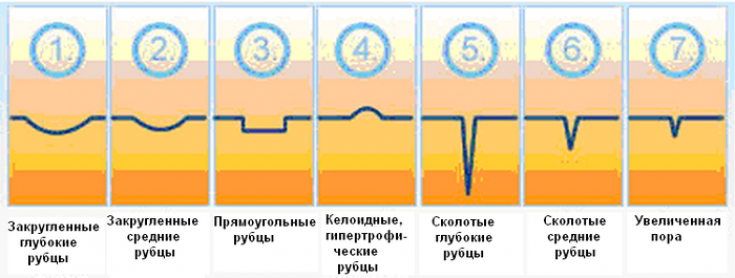Acne is a global problem. In this regard, doctors are constantly looking for ways to combat this disease, prevent and treat its complications. Despite the fact that most often, acne occurs in puberty, its consequences remind of themselves for the rest of their lives.
Post-acne scars are difficult to treat and often require serious cosmetic procedures. Aboutb features of the use of microneedle therapy in combination with PRP-plasma to combat post-acneread on estet-portal.com in this article.
Post-acne treatment: work with atrophic scars
There are three main types of acne scars: atrophic, hypertrophic, and keloid. Atrophic, due to local collagen deficiency occur most often (in 80% of cases).
Atrophic scars can be divided into several subgroups:
• chipped – deep V-shaped scars 0.1-0.5 mm deep;
• rectangular – wide U-shaped scars 0.1-0.5 mm deep;
• rounded – scars more than 4 mm wide.
Most often these subtypes of scars are very similar to each other, and, moreover, they can be simultaneously present on the skin of one patient.
For the latest articles, read Facebook!
Microneedle therapy and PRP-plasma in the treatment of post-acne
Microneedling therapy – This is a well-known and often recommended aesthetic procedure for post-acne. Its effect is realized due to the activation of collagenogenesis by microtraumatization of the skin. The impact of microneedles stimulates the migration of fibroblasts into the dermis.
The combination of microneedle therapy with PRP-plasma significantly increases the effectiveness of the treatment of atrophic scars after acne.
Platelet-enriched plasma contains a very high concentration of platelet-derived growth factors, which are activated upon contact with collagen.

Thus, microneedling therapy and PRP plasma work in tandem, activating the regenerative abilities of the skin.
Post-Acne Treatments: How to Smooth Out Facial Scars
Technical features of the combined use of microneedle therapy and PRP plasma
It should be remembered that microneedle therapy in combination with PRP plasma – this is just one of the methods available to the doctor and may not be suitable for everyone. Therefore, it is important to evaluate the individual characteristics of each patient.
The technique of the procedure is quite simple: a local anesthetic is applied in a thick layer on the face and left for 30 minutes, then it is necessary to treat the face with PRP plasma, concentrating in the scar area using a microneedle therapy device or using a dermaroller.
Microneedle therapy in combination with PRP plasma is a well tolerated, relatively inexpensive, highly effective technique with virtually no side effects.
Combined techniques are of great importance in the treatment of patients with post-acne, as they allow to achieve a pronounced result in a shorter time.
Read also: Post-Acne Therapy: Choice of Procedures Depending on the Type of Acne Scars







Add a comment